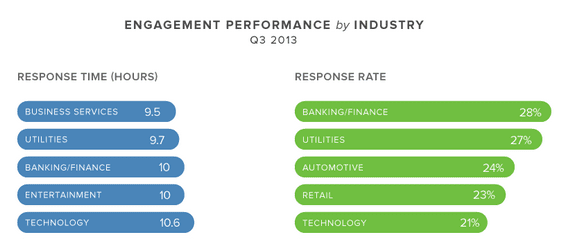Benchmark response times on delivering customer service via social media
When I started writing books about Internet Marketing in 2000, I was interested to look beyond ways to use the Internet to grow leads and sales. It seemed that Internet-based customer service 'Web Self-Service' as we called it would also have a strong role.
PR Smith and I emphasised this with the 5s Goals for businesses to consider in what we now call Digital Marketing. The 5Ss are Sell, Speak (a trialogue between a brand, it’s customers and other web users), Serve, Save, Sizzle (add value to the brand.)
We advised finding the gap between customer expectations of online service against what a brand was delivering and then trying to plug that gap by improving customer service.
So, what is the state of online customer service responsiveness today, specifically through social media?
Well back in the day, we were looking at response to email enquiries. Overall, they were appalling with many companies failing to respond at all, or if they did, many taking days rather than hours to respond. These days, the picture is much better for email response, since the tools such as Desk.com, Get Satisfaction and Help Scout.
But what about customer service delivered via Social media - how is that looking today?
Well, social media seems to be a popular channel for customer service, making it a key issue in social media strategy.
Smart Insights reported from a survey that in 2012 in the UK 44% of adults now use the web to share grievances showing the importance of trying to respond to initial complaints before customers get too vociferous.
On Facebook, the picture was even worse with analysis suggesting that in Autumn 2011 95% of Facebook posts were ignored by brands.
This latest data on social media customer care is from Sprout Social - it gives an idea of benchmarks for response in different industries which suggests response times by brands are much better today:

Here is the full infographic based on benchmarking from Sprout Social.

A more recent 2013 survey of US retailers suggests that retailers at least now have a better process, with the majority of companies responding to customers on Facebook and Twitter:

However, the average response times are nearly half a day on Twitter and approaching a day on Facebook which isn’t really 'Internet time' in line with the expectations of social media.
How does your customer service for social media compare?
Well the first step is to put in place the tools and KPIs for social media service to baseline your results. Then, work through the these guidelines from our 2012 post:
- Guideline 1. The customer service operation is equipped to monitor and engage with a targeted spectrum of media.
- Guideline 2. Fully understand where, why and how their customers are using social media before making any changes.
- Guideline 3. A balance is struck across different types of media – telephone, email, web, social and mobile.
- Guideline 4. The power of online communities is recognised, and customers are encouraged to help each other.
- Guideline 5. Relationships are nurtured with Advocates who wield particular influence on the Internet.
- Guideline 6. Specialist tools are used to measure the impact of customers’ online activity
Then, of course, there is the traditional marketing function of root-cause analysis, finding the most popular reasons for complaints and trying to resolve them.







